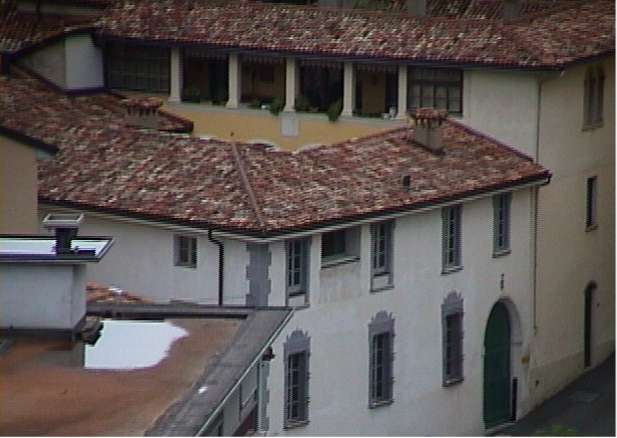Many historians have had an interest in studying this family’s history. Since it is one of the most important ones in Lombardy. However, they do not also agree as to how the family developed or scattered. Its stock came from the Valsassina.
The county of Valsassina was under the Torriani dominion, it had 57 municipalities over an area of 80 thousand square miles (128,720) and a population of about 20,000 inhabitants. The Torriani’s entered the chronicles ever since ll00 when they write about Bernardo, Ugone and Azzone in 1224. They were brothers and councillors in Milan’s municipality.
One must point out that in 1274 Napo Torriani had obtained the much desired approval to become Imperial vicar and therefore sovereign power from Rodolfo d’ Asburgo.
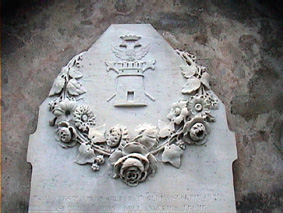
They were soon in conflict with the emerging Visconti family
The struggle for supremacy became crucial in 1276 when Ottone Visconti thought that time was ripe to eliminate the Torrianis and finally have a hold upon Milan.
Military operations took place between Arona, Angera and Castelseprio. Taken by surprise the three Torriani towers had to be surrendered. Then Napo della Torre sent his son, Cassone at the head of 500 German soldiers sent by Emperor Rodolfo d’ Asburgo against Angera who intended to join him as soon as possible with the great army.
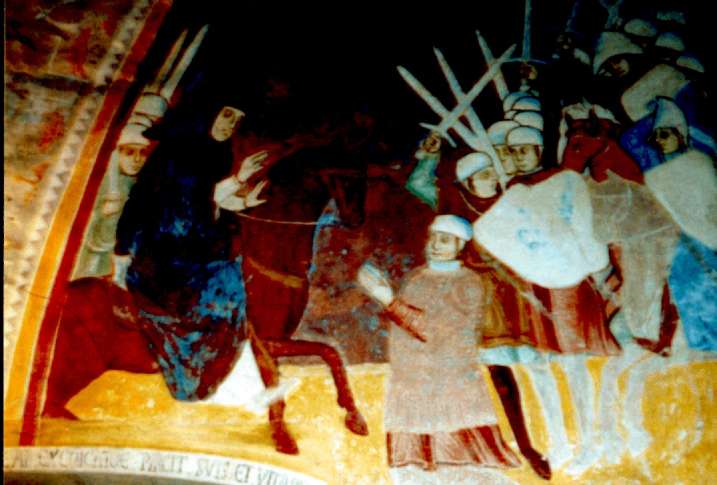
Cassone and his men were still camped on the shores of the Guassa torrent which was the way of communication to Lake Cadrezzate and to
the Lake Maggiore, when he was surprised by Goffredo di Langosco who was waiting to unite his forces with those of Ottone Visconti so as to surround the Torrianis.
Goffredo made a tragic mistake by attacking Cassone without noticing that Napo Torriani found himself in the vicinity with 10 thousand men. Goffredo easily defeated the Germans but was himself defeated by the Torriani troops.
Many noble Visconti partisans fell or were made prisoners. About thirty men
were beheaded in Gallarates square; amongst them were Goffredo di Langosco and Teobaldo Visconti who was the Archbishop’s nephew.
The fight went on with alternate defeats and victories until the 21st of January 1277 when the Torrianis were definitely defeated in the battle of Desio. Ottone Visconti finally made his entrance in Milan where he was acclaimed by the crowds. He remained there as master and leader until 1295.
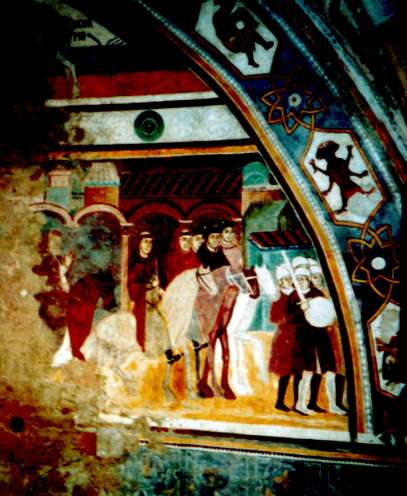
Napo Torriani was placed in an iron and wood cage in the Baradello tower at Como from where the cage hung until Napo Torriani died of hunger and desperation.
The properties of the Torriani family in Milan were pillaged and the members of the family scattered to different places. Having been defeated, humiliated and sent away from their own properties ,they escaped, formed new branches and developed considerably.
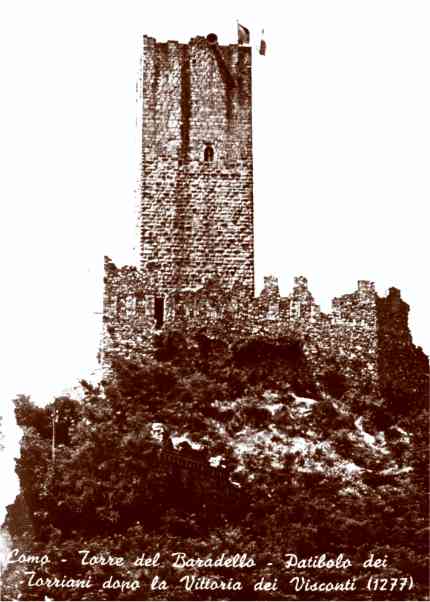
Author Giampiero Corti says:”already from the beginning of the X11th century the Torrianis flourished in Mendrisio and were certainly related to those who dominated in Valsassina who were the ancestors of Guglielmo who got to be Bishop of Como.”
According to Swiss author Hibner: “ the origin of the family is to be discussed… it seems to descend from Martino Count of Valsassina and Lord of Milan on 1147 who was imprisoned during the second crusade.”
Mendrisio, Palazzo Torriani, with the old Chapel and the Parlour, which
don't exist anymore
The Torrianis and particularly Guido made numerous attempts to reconquer Milan however vainly. He found refuge at Mendrisio after his family’s ruin and he was the first of the Torrianis that we now find at Mendrisio. He lived in a tower called dei Torriani which was levelled by the Viscontis whose hate and vengeance would reach his enemies wherever they went. The Torrianis embellished and restored the Church of San Sisinio, and later were its patrons.
Gasparo lived in Mendrisio and in 1426 he sat amongst Como’s decurions.His economic possibilities were firmly established and in a short time the family had vast possessions in Val di Blenio, Castel San Pietro, Sorengo, Vacillo etc. He was granted the citizenship o Milan at a very late age.
His son, Giovanni, was an outstanding priest and archpriest at Balerna,. Dionisio had a son in 1470 named Bartolomeo who became parish priest at Ligornetto. Girolamo became a doctor and Luigi was a priest who became a member of the Sacred Rota. Then we have Michelangelo who was a doctor at law known by the name of Eliseo as well as Gianpietro also a priest.
His nephew Francesco was mayor of Mendrisio in 1521., Donato held the same position in Balerna 1474 and 1477 as well as Giovanbattista who was regent of Mendrisio in 1779.
Francesco Torriani was born in 1612 who became a painter and well known artist of whom l’Oldelli and Simona speak about.He painted oils for the Muri Abbey at Argovia. These paintings were destroyed by fire in 1889. Other works of his were sold to England.
His son, Francesco Innocenzo, born in 1646 painted “The Martyrdom of Saint Orsola” and an oil entitled “Offer to the Temple” in Morbio Inferiores’ church.
Niccolò Aurelio Torriani owned a Palace in Mendrisio which is called Palazzo Pollini after the family that bought and sold it.
It was inherited by Anna Maria Ferrari from Vigevano who was Niccolo’s cousin. She married Count Confalonieri, who was the great grandfather of the famous patriot called after him.
Because of this marriage the Confalonieris added the Torriani name to their own .
One can see the Confalonieris’ tombstone in San Sisinios’ church.
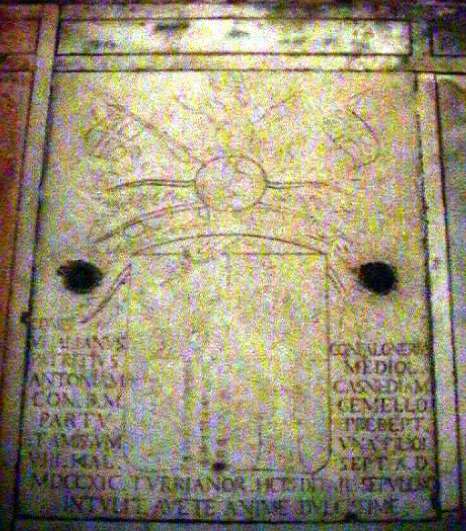
The Torriani descendants are to
be recognised as noblemen for they had the privilege of owning a private parish, San Sisinio
Church, a private cemetery.
They can count on numerous illustrious persons amongst their ascendants, and they lived “more nobilium” during long centuries.
The coat of arms is sculpted on the churches’ tombstones. It has been used since ancient times.
The Imperial Eagle was placed in it as a reminiscence of the fact that Napo Torriani had been appointed Empire’ s Vicar by Emperor Rodolfo 1 of Absburg in 1273.
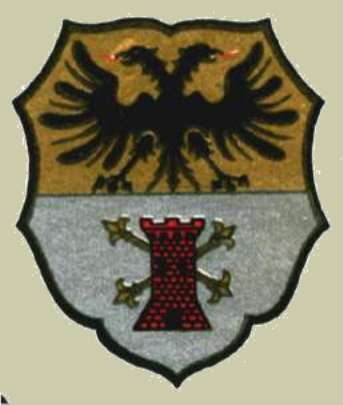
Bibliography on the history of the Church and the Family Torriani
